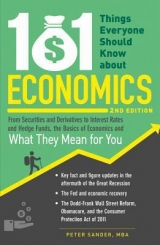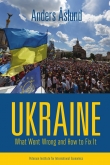
Текст книги "101 Things Everyone Should Know about Economics: From Securities and Derivatives to Interest Rates and Hedge Funds, the Basics of Economics and What They Mean for You"
Автор книги: Peter Sander
Жанры:
Экономика
,сообщить о нарушении
Текущая страница: 14 (всего у книги 14 страниц)
Why You Should Care
Why you should care about protectionism is really the flip side of why you should care about trade agreements and free trade. Protectionism might help you save a job, but you need to ask yourself whether you should be engaged in that activity anyway if there are lower-cost producers elsewhere. And protectionism is a two-way street—sure, your job can be protected. But suppose you work in an industry that exports to other countries, and they decide to enact trade barriers on the products you produce? You would lose on that one.
If you think it through, you should prefer natural competition and evolution of comparative advantage. Protectionism and especially trade wars can get really nasty. Even if you work for a protected industry, supporting such an idea may hurt you in the long run.
99. INTERNATIONAL MONETARY FUND (IMF) AND WORLD BANK
The International Monetary Fund and World Bank are household names for most who watch the evening news, yet most don’t understand their roles in the world economy. And their roles are not without controversy on the world stage.
What You Should Know
The International Monetary Fund is kind of a United Nations of money and monetary policy. Originally created at the end of World War II, its purpose and goal was to stabilize exchange rates and create world policies for monetary exchange by influencing the macroeconomic policies of member countries. It conducts economic research, acts to advise and help member nations with financial policy, and has also assumed a role as lender of last resort in economic crises, mainly to the benefit of underdeveloped nations.
Originally chartered with forty-four countries, today’s IMF has 188 countries, and with a few exceptions, maps the membership in the United Nations almost exactly. It is located in Washington, D.C. Funding and government are complicated, but not surprisingly the United States is both the largest provider of funds and also carries the greatest voting weight on decisions. Some countries bristle at the power of larger members (referred to as the “imperial power of the north” by the late Venezuelan president Hugo Chavez) but maintain membership because it is a condition to be able to borrow funds on the world stage.
The IMF has met some criticism over the years for funding “military dictatorships,” and more recently for suggesting dubious economic policy, which got Argentina in trouble in 2001. Many of its critics consider its policies and recommendations to be overly rooted in Keynesian policies of taxation and government intervention, not the more recently stylish monetary policies (see #57 and #56). Still, over the years, IMF activities have done a lot to stabilize international economics, foster globalization, and help countries make informed economic decisions.
The World Bank is also located in Washington, D.C., and was born of the same conference at the end of WWII that created the IMF. But it is less involved in economic policy and monetary exchange and rather more involved in actually funding development of infrastructure and socioeconomic programs in underdeveloped countries. A stated purpose is the creation of an environment suitable for “investment, jobs, and sustainable growth.” The World Bank faces some of the same criticisms as the IMF for trying to impose a U.S.– or Western-centric approach onto recipient nations, which often doesn’t work, or worse, creates conflict within and among these nations. The World Bank obtains funds by selling bonds and from contributions from about forty of its 187 member countries.
Why You Should Care
The activities of the IMF and World Bank aren’t likely to affect your daily life. It’s nice to know that there are organizations in place to serve to develop international cohesion and progress on a world front, and to coordinate globalization, at least to a degree.
100. WORLD TRADE ORGANIZATION
While the IMF and the World Bank concern themselves with matters of international finance, the World Trade Organization (WTO) concerns itself with the process, policies, and procedures of international trade. The WTO as known today is relatively new, dating back to 1995, succeeding the General Agreement on Tariffs and Trade, or GATT, formed in 1947.
What You Should Know
The World Trade Organization regulates trade and the process of trade between participating countries, providing a procedure and framework for developing trade policies and agreements. The goal is to promote free trade, fair trade, and to stimulate economic growth through trade.
The WTO and its predecessors provided an active forum to negotiate and discuss trade policy. Every few years a new “round” of discussions occurs, typically resulting in the relaxation or elimination of tariffs on certain goods, like agricultural commodities, and new rules, like the antidumping rules adopted in the 1960s. (Antidumping makes it illegal for nations to “dump” goods on another country’s market at prices below cost or below prices charged in the home market.) The recent “Uruguay Round” commenced in 1986 and was the largest to date, lasting eighty-seven months, including 123 countries, creating the WTO as an organizational framework, and creating new rules around intellectual property, among other accomplishments. The “Doha Round,” which has been in progress since 2001, is expanding beyond traditional trade issues to cover environmental concerns, and is aimed at the needs of developing countries. It has been bogged down by concerns, mainly about agricultural trade and farm subsidies.
The WTO and its negotiations do not actually produce tariffs or other trade policies; they instead create a forum or framework of fairness for doing so. WTO members cannot discriminate against other WTO members; that is, the same trade policies and tariffs apply to any country selling a similar good, and member countries agree to treat each other as “most favored nations.” WTO rules also call for transparency and clarity on tariffs and tariff schedules.
The WTO has gone a long way toward fostering globalization; without the WTO world trade would likely be much more tangled up with complex, “one-off” policies and high tariffs. Critics of the WTO make the same arguments as critics of globalization—that it makes it harder to protect local industries, and causes greater income divergence between rich and poor nations. Agreements can take a long time, and some complain that traditional industries like local agriculture can be hurt by WTO actions and agreements.
Why You Should Care
The WTO and resulting globalization play an important role in expanding trade and making more goods available to more people worldwide at more reasonable prices. The trade wars that would result without WTO would make the supply of some products and commodities unpredictable and expensive. The WTO groundwork creates stability in international trade, so you can take comfort in finding what you buy today at similar prices tomorrow.
101. G8 ECONOMIC SUMMITS
You hear a lot about the “G” summits on the nightly news and from various other news sources. But what exactly are these summits? Are they just suit-and-tie photo-ops for the participating nations and leaders, or do they really accomplish something? And most of all, how do they affect you?
What You Should Know
The G8, or Group of Eight, sessions were started in 1975 for the economic heavyweights of the Northern Hemisphere in response to the global energy crisis of 1974. Originally, it was the G6—the United States, France, Germany, Italy, Japan, and the United Kingdom—but in recent years it expanded to include Canada and then Russia. These eight countries represent 14 percent of the world’s population but some 60 percent of the world’s economic activity.
The summits include the heads of government—presidents, vice presidents, and prime ministers—as well as finance ministers and special envoys. They are informal in nature, with no specified outcome and little in the way of administrative structure. Topics are broad and include most anything of global concern, including economic development, world health, energy, environment, trade, terrorism and political turmoil, and an assortment of other issues that not only concern the eight nations but also the world at large. Leaders may discuss and come to an agreement on an approach to an issue, but these agreements aren’t binding, and action is subject to subsequent actions on the part of participating country governments, the United Nations, the World Bank, and other organizations.
The G8 has famously provided the setting for sizeable and visible protests, recently on issues related to the environment and globalization (see #91), and has also been linked to acts of terrorism, as in 2005 when the London bus bombings occurred while a G8 summit was being held in Scotland.
Why You Should Care
The G8 summits are so high-level and far-reaching that little of what comes out of them will affect you directly or immediately. But it’s good to keep track of world direction on key issues such as the three Es—economy, environment, and energy—that are discussed at these summits, and will affect all of us eventually. Aside from specific outcomes, these summits will give you a sense of what the current global priorities are.
ACKNOWLEDGMENTS
I would like to recognize my editor, Peter Archer, for coming up with the “101 Economics” concept as a simplified, commonsense way to present a difficult and typically dry topic. Of course, as with all of my books, my boys Julian and Jonathan and new life partner Marjorie get credit for the inspiration and support to keep writing.
Copyright © 2014, 2009 by F+W Media, Inc.
All rights reserved.
This book, or parts thereof, may not be reproduced in any form without permission from the publisher; exceptions are made for brief excerpts used in published reviews.
Published by
Adams Media, a division of F+W Media, Inc.
57 Littlefield Street, Avon, MA 02322 U.S.A.
www.adamsmedia.com
ISBN 10: 1-4405-7271-2
ISBN 13: 978-1-4405-7271-5
eISBN 10: 1-4405-7272-0
eISBN 13: 978-1-4405-7272-2
Many of the designations used by manufacturers and sellers to distinguish their product are claimed as trademarks. Where those designations appear in this book and F+W Media was aware of a trademark claim, the designations have been printed with initial capital letters.
Cover image © 123RF.com.
Table 2.2 Misery Index by President
President
Period
Average Misery Index
Overall Rank
Harry Truman
1948–52
7.78
5
Dwight Eisenhower
1953–60
6.26
1 (best)
John F. Kennedy
1961–62
7.14
3
Lyndon Johnson
1963–68
6.77
2
Richard Nixon
1969–73
10.57
7
Gerald Ford
1974–76
16.0
11
Jimmy Carter
1977–80
16.26
12 (worst)
Ronald Reagan
1981–88
12.19
10
George H. W. Bush
1989–92
10.68
9
Bill Clinton
1993–2000
7.80
4
George W. Bush
2001–08
8.11
6
Barack Obama
2009–present
10.48
8
Source: miseryindex.us
Return to main text
Time to Maturity
1 mo
2 mo
6 mo
1 yr
2 yr
3 yr
5 yr
10 yr
20 yr
30 yr
Treasury Yield
0.01%
0.04
0.09
0.15
.034
.065
1.39
1.93
3.19
3.48
Return to main text
Table 8.1 U.S. Balance of Trade 2000–2012 ($ Billion)
Year
Total
Goods
Services
2000
−379,835
−454,690
74,855
2001
−365,505
−429,898
64,393
2002
−421,601
−482,831
61,230
2003
−495,035
−549,012
53,977
2004
−609,987
−671,835
61,848
2005
−715,269
−790,851
75,582
2006
−760,359
−847,260
86,901
2007
−701,423
−830,992
129,569
2008
−702,302
−833,957
131,655
2009
−383,657
−510,550
128,893
2010
−499,379
−650,156
150,777
2011
−556,359
−744,139
187,301
2012
−534,656
−741,475
208,819
Source: U.S. Census Bureau
Return to main text






![Книга Make Winning a Habit [с таблицами] автора Rick Page](http://itexts.net/files/books/110/no-cover.jpg)
